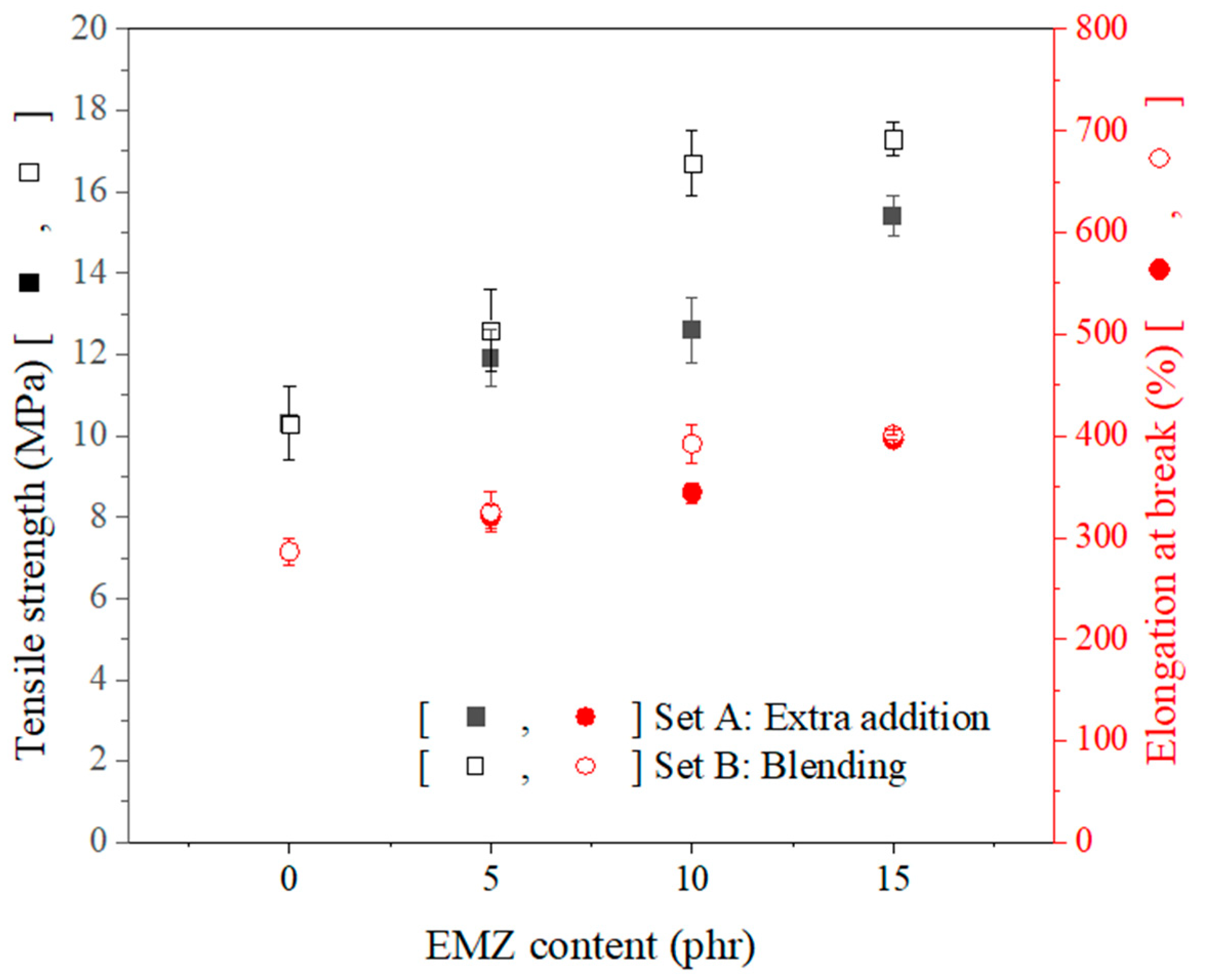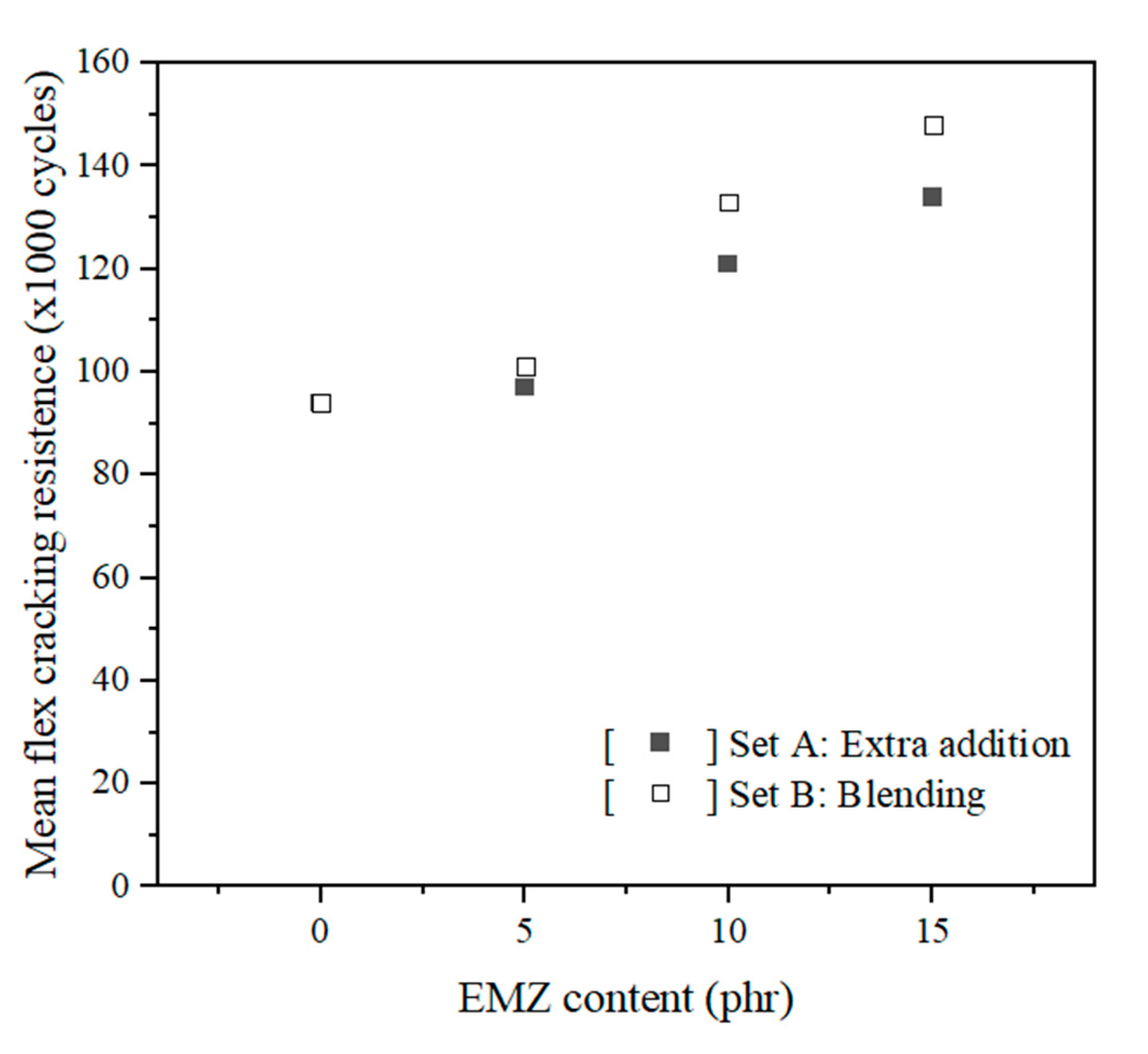A Self-Healing System Based on Ester Crosslinks for Carbon Black-Filled Rubber Compounds
Abstract
1. Introduction
2. Materials and Methods
2.1. Materials
2.2. Sample Preparation
2.2.1. Preparation of the Self-Healing Modifier
2.2.2. Compound Preparation
2.3. Characterizations
2.3.1. Cure Characteristics and Mooney Viscosity
2.3.2. Apparent Crosslink Density
2.3.3. Bound Rubber Content as Indicative of Filler–Rubber Interaction
2.3.4. Tensile Properties
2.3.5. Payne Effect as Indicative of Filler–Filler Interaction
2.3.6. Flex Cracking Resistance
2.3.7. Fatigue Resistance
2.3.8. Assessing the Self-Reparation of Molecular Damages in Vulcanizates
3. Results and Discussion
3.1. Compound Viscosities, Cure Characteristics and Intermolecular Networks
3.2. Mechanical and Fatigue Properties
3.3. Self-Healing Performance
4. Conclusions
Author Contributions
Funding
Conflicts of Interest
References
- Waddell, W.H. Tire black sidewall surface discoloration and non-staining technology: A review. Rubber Chem. Technol. 1998, 71, 590–618. [Google Scholar] [CrossRef]
- Ghosh, S.; Bhattacharyya, S.K.; Bandyopadhyay, S.; Dasgupta, S.; Mukhopadhyay, R. Development of a Passenger-Car Radial-Tyre Sidewall Compound by the Reactive Processing of an NR/BR/EPDM Blend in a Banbury Mixer. Prog. Rubber Plast. Recycl. Technol. 2012, 28, 15–26. [Google Scholar] [CrossRef]
- Algaily, B.; Kaewsakul, W.; Sarkawi, S.S.; Kalkornsurapranee, E. Alleviating molecular-scale damages in silica-reinforced natural rubber compounds by a self-healing modifier. Polymers 2020, 13, 39. [Google Scholar] [CrossRef]
- Sahakaro, K.; Datta, R.N.; Baaij, J.; Noordermeer, J.W.M. Blending of NR/BR/EPDM by reactive processing for tire sidewall applications. III. Assessment of the blend ozone- and fatigue-resistance in comparison with a conventional NR/BR compound. J. Appl. Polym. Sci. 2007, 103, 2555–2563. [Google Scholar] [CrossRef]
- Hernández Santana, M.; Huete, M.; Lameda, P.; Araujo, J.; Verdejo, R.; López-Manchado, M.A. Design of a new generation of sustainable SBR compounds with good trade-off between mechanical properties and self-healing ability. Eur. Polym. J. 2018, 106, 273–283. [Google Scholar] [CrossRef]
- Le, H.H.; Hait, S.; Das, A.; Wiessner, S.; Stoeckelhuber, K.W.; Boehme, F.; Uta, R.; Naskar, K.; Heinrich, G.; Radusch, H.J. Self-healing properties of carbon nanotube filled natural rubber/bromobutyl rubber blends. Express Polym. Lett. 2017, 11, 230–242. [Google Scholar] [CrossRef]
- Hernández Santana, M.; den Brabander, M.; García, S.; van der Zwaag, S. Routes to make natural rubber heal: A Review. Polym. Rev. 2018, 58, 585–609. [Google Scholar] [CrossRef]
- Chino, K.; Ashiura, M. Themoreversible cross-linking rubber using supramolecular hydrogen-bonding networks. Macromolecules 2001, 34, 9201–9204. [Google Scholar] [CrossRef]
- Das, A.; Sallat, A.; Bohme, F.; Suckow, M.; Basu, D.; Wiessner, S.; Stockelhuber, K.W.; Voit, B.; Heinrich, G. Ionic modification turns commercial rubber into a self-healing material. ACS Appl. Mater. Interfaces 2015, 7, 20623–20630. [Google Scholar] [CrossRef] [PubMed]
- Polgar, L.M.; Kingma, A.; Roelfs, M.; van Essen, M.; van Duin, M.; Picchioni, F. Kinetics of cross-linking and de-cross-linking of EPM rubber with thermoreversible Diels-Alder chemistry. Eur. Polym. J. 2017, 90, 150–161. [Google Scholar] [CrossRef]
- Canadell, J.; Goossens, H.; Klumperman, B. Self-healing materials based on disulfide links. Macromolecules 2011, 44, 2536–2541. [Google Scholar] [CrossRef]
- Denissen, W.; Winne, J.M.; Du Prez, F.E. Vitrimers: Permanent organic networks with glass-like fluidity. Chem. Sci. 2016, 7, 30–38. [Google Scholar] [CrossRef]
- Zhang, H.; Cai, C.; Liu, W.; Li, D.; Zhang, J.; Zhao, N.; Xu, J. Recyclable polydimethylsiloxane network crosslinked by dynamic transesterification reaction. Sci. Rep. 2017, 7, 11833. [Google Scholar] [CrossRef]
- Kloxin, C.J.; Bowman, C.N. Covalent adaptable networks: Smart, reconfigurable and responsive network systems. Chem. Soc. Rev. 2013, 42, 7161–7173. [Google Scholar] [CrossRef]
- Bowman, C.N.; Kloxin, C.J. Covalent adaptable networks: Reversible bond structures incorporated in polymer networks. Angew. Chem. Int. Ed. Engl. 2012, 51, 4272–4274. [Google Scholar] [CrossRef]
- Tang, Z.; Liu, Y.; Guo, B.; Zhang, L. Malleable, mechanically strong, and adaptive Elastomers enabled by interfacial exchangeable bonds. Macromolecules 2017, 50, 7584–7592. [Google Scholar] [CrossRef]
- Cao, L.M.; Fan, J.F.; Huang, J.R.; Chen, Y.K. A robust and stretchable cross-linked rubber network with recyclable and self-healable capabilities based on dynamic covalent bonds. J. Mater. Chem. A 2019, 7, 4922–4933. [Google Scholar] [CrossRef]
- Montarnal, D.; Capelot, M.; Tournilhac, F.; Leibler, L. Silica-like malleable materials from permanent organic networks. Science 2011, 334, 965–968. [Google Scholar] [CrossRef] [PubMed]
- Pire, M.; Norvez, S.; Iliopoulos, I.; Le Rossignol, B.; Leibler, L. Imidazole-promoted acceleration of crosslinking in epoxidized natural rubber/dicarboxylic acid blends. Polymer 2011, 52, 5243–5249. [Google Scholar] [CrossRef]
- Imbernon, L.; Norvez, S.; Leibler, L. Stress relaxation and self-adhesion of rubbers with exchangeable links. Macromolecules 2016, 49, 2172–2178. [Google Scholar] [CrossRef]
- Algaily, B.; Kaewsakul, W.; Sarkawi, S.S.; Kalkornsurapranee, E. Enabling reprocessability of ENR-based vulcanizates by thermochemically exchangeable ester crosslinks. Plast. Rubber Compos. 2021, Accepted. [Google Scholar]
- Algaily, B.; Kaewsakul, W.; Kalkornsurapranee, E. Enabling reprocessability of ENR vulcanizates by thermo-chemically exchangeable crosslinks. In Proceedings of the 10th International Polymer Conference of Thaialnd, Virtually Organized Conference, Bangkok, Thailand, August 6–7 2020; pp. 217–220. [Google Scholar]
- Harwood, J.A.C.; Payne, A.R. Stress softening in natural rubber vulcanizates. Part IV. Unfilled vulcanizates. J. Appl. Polym. Sci. 1966, 10, 1203–1211. [Google Scholar] [CrossRef]
- Mullins, L. Effect of stretching on the properties of rubber. Rubber Chem. Technol. 1948, 21, 281–300. [Google Scholar] [CrossRef]
- Diani, J.; Fayolle, B.; Gilormini, P. A review on the Mullins effect. Eur. Polym. J. 2009, 45, 601–612. [Google Scholar] [CrossRef]
- Hanson, D.E.; Hawley, M.; Houlton, R.; Chitanvis, K.; Rae, P.; Orler, E.B.; Wrobleski, D.A. Stress softening experiments in silica-filled polydimethylsiloxane provide insight into a mechanism for the Mullins effect. Polymer 2005, 46, 10989–10995. [Google Scholar] [CrossRef]
- Flory, P.J.; Rehner, J. Statistical mechanics of cross-linked polymer networks II. swelling. J. Chem. Phys. 1943, 11, 521–526. [Google Scholar] [CrossRef]
- Moon, B.; Lee, J.; Park, S.; Seok, C.S. Study on the aging behavior of natural rubber/butadiene rubber (NR/BR) blends using a parallel spring model. Polymers 2018, 10, 658. [Google Scholar] [CrossRef]
- Fu, W.; Wang, L. Research on Payne effect of natural rubber reinforced by graft-modified silica. J. Appl. Polym. Sci. 2016, 133. [Google Scholar] [CrossRef]
- Tripathi, R.; Sharma, P.; Saini, A.; Verma, G. Self-healed Materials from Elastomeric Composites: Concepts, Strategies and Developments. In Smart Polymer Nanocomposites; Ponnamma, D., Sadasivuni, K.K., Cabibihan, J.-J., Al-Maadeed, M.A.-A., Eds.; Springer International Publishing AG: Cham, Switzerland, 2017; pp. 219–242. [Google Scholar]
- Marckmann, G.; Verron, E.; Gornet, L.; Chagnon, G.; Charrier, P.; Fort, P. A theory of network alteration for the Mullins effect. J. Phys. Chem. Solids 2002, 50, 2011–2028. [Google Scholar] [CrossRef]
- Laraba-Abbes, F.; Ienny, P.; Piques, R. A new ‘Tailor-made’ methodology for the mechanical behaviour analysis of rubber-like materials: II. Application to the hyperelastic behaviour characterization of a carbon-black filled natural rubber vulcanizate. Polymer 2003, 44, 821–840. [Google Scholar] [CrossRef]
- Hernandez, M.; Grande, A.M.; van der Zwaag, S.; Garcia, S.J. Monitoring network and interfacial healing processes by broadband dielectric spectroscopy: A case study on natural rubber. ACS Appl. Mater. Interfaces 2016, 8, 10647–10656. [Google Scholar] [CrossRef]
- Song, F.; Li, Z.; Jia, P.; Zhang, M.; Bo, C.; Feng, G.; Hu, L.; Zhou, Y. Tunable “soft and stiff”, self-healing, recyclable, thermadapt shape memory biomass polymers based on multiple hydrogen bonds and dynamic imine bonds. J. Mater. Chem. A 2019, 7, 13400–13410. [Google Scholar] [CrossRef]
- Sadequl, A.M. The effect of accelerator/sulphur ratio on the cure time and torque maximum of epoxidized natural rubber. Int. J. Polym. Mater. 2000, 46, 597–615. [Google Scholar] [CrossRef]
- Kharel, A.; Jin, J.; Sattayanurak, S.; Kaewsakul, W.; Noordermeer, J.W.M.; Dierkes, W.K.; Blume, A. Micro- and macro-dispersion of silica-filled tire tread compounds. In Proceedings of the 197th Technical Meeting ACS Rubber Division, Independence, MO, USA, 27–29 April 2020. [Google Scholar]
- Mgbemena, C.O.; Ihueze, C.C.; Menon, A.R.R. Performance characteristics and analysis of tailored Natural Rubber/Organo-kaolin Composites. Int. J. Plast. Technol. 2016, 20, 11–27. [Google Scholar] [CrossRef]
- Kaewsakul, W.; Dierkes, W.K.; Blume, A. Defining key factors in carbon black-filled NR/BR compounds for balancing aircraft tire tread properties. J. Compos. Sci. 2019, 3, 47. [Google Scholar] [CrossRef]
- Böhm, G.G.A.; Nguyen, M.N. Flocculation of carbon black in filled rubber compounds. I. Flocculation occurring in unvulcanized compounds during annealing at elevated temperatures. J. Appl. Polym. Sci. 1995, 55, 1041–1050. [Google Scholar] [CrossRef]
- Mohamad Aini, N.; Othman, N.; Hussin, M.; Sahakaro, K.; Hayeemasae, N. Hydroxymethylation-modified lignin and its effectiveness as a filler in rubber composites. Processes 2019, 7, 315. [Google Scholar] [CrossRef]
- Zhang, H.; Datta, R.N.; Talma, A.G.; Noordermeer, J.W.M. Maleic-anhydride grafted EPM as compatibilising agent in NR/BR/EPDM blends. Eur. Polym. J. 2010, 46, 754–766. [Google Scholar] [CrossRef]
- Fu, X.; Huang, C.; Zhu, Y.; Huang, G.; Wu, J. Characterizing the naturally occurring sacrificial bond within natural rubber. Polymer 2019, 161, 41–48. [Google Scholar] [CrossRef]
- Zhou, X.; Guo, B.; Zhang, L.; Hu, G.H. Progress in bio-inspired sacrificial bonds in artificial polymeric materials. Chem. Soc. Rev. 2017, 46, 6301–6329. [Google Scholar] [CrossRef] [PubMed]
- Fu, F.; Huang, M.; Zhang, W.; Zhao, Y.; Liu, X. Thermally assisted self-healing behavior of anhydride modified polybenzoxazines based on transesterification. Sci. Rep. 2018, 8, 10325. [Google Scholar] [CrossRef] [PubMed]








| Ingredients | Dosage (Phr) | ||||||
|---|---|---|---|---|---|---|---|
| Ref. | Set A: Extra Addition of EMZ a | Set B: Blending of EMZ b | |||||
| S0 | E-S5 | E-S10 | E-S15 | B-S5 | B-S10 | B-S15 | |
| NR c (STR 5L d) | 50 | 50 | 50 | 50 | 47.5 | 45 | 42.5 |
| BR e | 50 | 50 | 50 | 50 | 47.5 | 45 | 42.5 |
| EMZ f | 0 | 5 | 10 | 15 | 6.2 | 12.3 | 18.5 |
| Carbon black (HAF, N330 g) | 50 | The quantities of these compositions are the same with those added for the reference (Ref.) compound (S0). | |||||
| Process oil (TDAE h) | 10 | ||||||
| TMQ i | 1 | ||||||
| 6PPD j | 2.5 | ||||||
| Paraffin Wax | 1.5 | ||||||
| Zinc oxide | 4 | ||||||
| Stearic acid | 2 | ||||||
| CBS k | 2 | ||||||
| Sulfur | 2.5 | ||||||
| Compounds | Cure Characteristics | |||||
|---|---|---|---|---|---|---|
| TS2 a (Min) | TC90 b (Min) | S`Min c (dN.m) | S`Max d (dN.m) | S`Max–S`Min e (dN.m) | CRI f | |
| S0 | 0.58 | 4.39 | 0.77 | 13.23 | 12.46 | 26.2 |
| E-S5 | 0.58 | 4.32 | 0.81 | 13.30 | 12.49 | 26.7 |
| E-S10 | 0.49 | 3.52 | 0.83 | 13.55 | 12.72 | 33.0 |
| E-S15 | 0.40 | 3.47 | 0.87 | 13.96 | 13.09 | 32.6 |
| B-S5 | 0.56 | 3.95 | 0.82 | 13.98 | 13.16 | 29.4 |
| B-S10 | 0.38 | 3.49 | 0.85 | 14.28 | 13.43 | 32.2 |
| B-S15 | 0.36 | 3.35 | 0.89 | 15.21 | 14.32 | 33.4 |
Publisher’s Note: MDPI stays neutral with regard to jurisdictional claims in published maps and institutional affiliations. |
© 2021 by the authors. Licensee MDPI, Basel, Switzerland. This article is an open access article distributed under the terms and conditions of the Creative Commons Attribution (CC BY) license (http://creativecommons.org/licenses/by/4.0/).
Share and Cite
Algaily, B.; Kaewsakul, W.; Sarkawi, S.S.; Kalkornsurapranee, E. A Self-Healing System Based on Ester Crosslinks for Carbon Black-Filled Rubber Compounds. J. Compos. Sci. 2021, 5, 70. https://doi.org/10.3390/jcs5030070
Algaily B, Kaewsakul W, Sarkawi SS, Kalkornsurapranee E. A Self-Healing System Based on Ester Crosslinks for Carbon Black-Filled Rubber Compounds. Journal of Composites Science. 2021; 5(3):70. https://doi.org/10.3390/jcs5030070
Chicago/Turabian StyleAlgaily, Bashir, Wisut Kaewsakul, Siti Salina Sarkawi, and Ekwipoo Kalkornsurapranee. 2021. "A Self-Healing System Based on Ester Crosslinks for Carbon Black-Filled Rubber Compounds" Journal of Composites Science 5, no. 3: 70. https://doi.org/10.3390/jcs5030070
APA StyleAlgaily, B., Kaewsakul, W., Sarkawi, S. S., & Kalkornsurapranee, E. (2021). A Self-Healing System Based on Ester Crosslinks for Carbon Black-Filled Rubber Compounds. Journal of Composites Science, 5(3), 70. https://doi.org/10.3390/jcs5030070







